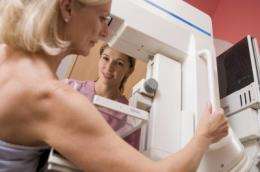BreastScreen: balancing benefits and harms

New research has questioned the relative impact of mammographic screening in reducing deaths from breast cancer, concluding that it is not responsible for most of the recent reduction in mortality rates and may in fact cause unnecessary surgery through over-diagnosis.
The Federal Government launched Breastscreen Australia, a free mammography screening program for women over 40 in 1991. In the twenty years since the program was implemented, mortality rates for breast cancer have declined by 28 per cent.
In research published in Breast Cancer Research and Treatment Monash University researchers concluded that the majority of that reduction cannot be attributed to earlier diagnosis through mammographic screening, but is the result of improvements in treatment.
Monash University researchers, Associate Professor Robin Bell, Women’s Health Program, with Professor Robert Burton, Dr. Geetha Thiagarajah, and Dr. Christopher Stevenson of the Department of Epidemiology and Preventive Medicine analysed data from BreastScreen Australia and the Australian Institute of Health and Welfare.
Associate Professor Bell said that almost 60 per cent of the decline in breast cancer mortality rates occurred before BreastScreen could have had an effect.
“Additionally, the age group showing the greatest decline in mortality over the study period had the lowest participation rates in BreastScreen,” Associate Professor Bell said.
“When you drill down further into the data, the group with the highest screening participation rate showed no significant reduction in mortality in the period when BreastScreen should have been making an impact.
“Evidence suggests that the welcome decline in mortality rates probably results from increased use of adjuvant therapies to surgery and radiotherapy, such as chemotherapy and endocrine therapy. It’s not that we’re finding cancers earlier, it’s that we’re getting much better at treating them.”
The concern about over-diagnosis has been echoed internationally with one study finding that one in three cancers are over-diagnosed.
“Mammographic screening is able to detect cancers before they exhibit symptoms, which can be very helpful. However, not all cancers are lethal. In some cases, they are indolent and were women not screened, they would live healthy, happy lives never knowing that they had cancer,” Associate Professor Bell said.
“Doctors of course, cannot know which cancers will develop into a health threat, so all detected cancers are treated. This is an important area for research for the future so we get much better at determining which cancers are likely to progress.
“Women need to be better informed about the full implications of breast screening, and of undergoing treatment for asymptomatic cancer,” she said.
"We need to be able to clearly communicate these issues to women so they are able to make an informed choice."















